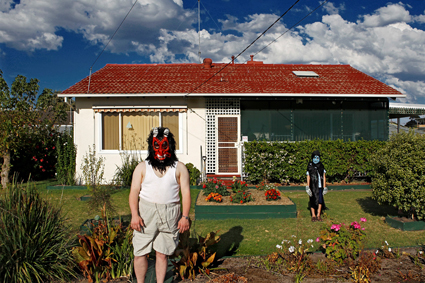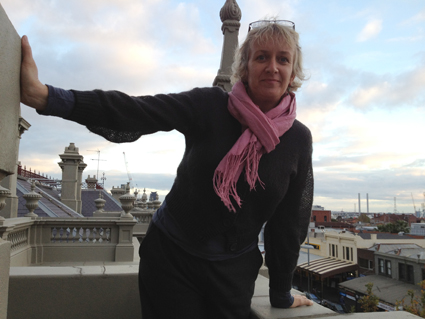hell house, hot house, arts house
keith gallasch: interview, angharad wynne-jones, arts house

Hell House, Back to Back
photo Jeff Busby
Hell House, Back to Back
ARTS HOUSE, A MAJOR CITY OF MELBOURNE CONTEMPORARY ARTS INITIATIVE, IS BASED AT THE OLD NORTH MELBOURNE TOWN HALL. PERFORMANCES ARE PRESENTED IN THE HALL, AT THE ADJOINING WAREHOUSE AND THE NEARBY MEAT MARKET. ARTS HOUSE HAS BECOME A PIVOTAL CULTURAL CENTRE FOR THE CURATED STAGING OF INNOVATIVE LOCAL, NATIONAL AND INTERNATIONAL PERFORMANCE. I SPOKE WITH CREATIVE PRODUCER ANGHARAD WYNNE-JONES ABOUT ARTS HOUSE AND ITS PROGRAM FOR THE SECOND HALF OF 2012.
What attracted you to the job as Creative Producer at Arts House?
In 2008 I came back from the UK where I’d been artistic director of the London International Festival of Theatre [LIFT] for three and a half years, and one of the things I really noted was how exciting it was to feel that there was a venue in the city that was presenting work that felt internationally aligned. There’s not a huge percentage of the work that is international, for obvious reasons, but international work was consistently being programmed. It was of a scale and scope that connected really strongly for me with the way that artists were working in the city, which I think can be quite different from some of the work we see within the international arts festival scenarios. There it’s often brilliantly spectacular, big scale and impressive in other ways but I really enjoyed that sense that Arts House was a kind of connecter on the international network of contemporary practice.
Also, it’s interesting for me that Arts House is a council venue with a sense of history, of being connected to a residential community in North Melbourne and having become a cultural centre. I was interested in re-locating some of those connections between the venue’s historical civic function and its cultural function.
Is the Meat Market still a significant part of your ambit?
It is and it’s a most amazing asset. It’s owned by Arts Victoria but managed by the City, which cannot invest its own programming funds into the Meat Market. Any program we do there has to come from funds outside of the City. It’s an incredible resource both for the city and for the state but it is clearly under-used currently. I think that’s generally understood by all of the stakeholders. I feel confident that there will be an investment in it as a really critical cultural space.
We’ve also got a new space that’s just come online—the Warehouse, just out the back of the Town Hall. It’s very small with a capacity of 60 but already we have a program of work called Warehouse Salon where artists can talk about their work, have a beer and a pizza.

Angharad Wynne-Jones
courtesy Arts House
Angharad Wynne-Jones
You have a strong interest in the environment and its survival. Is that reflected in your directorship? [Wynne-Jones is currently the Producer of TippingPoint Australia—an international network of scientists and artists engaging with climate change; RT100]
Yes. I think the City of Melbourne—also the City of Sydney—is exemplary in terms of government organisations in setting standards. The target for City of Melbourne is zero emissions by 2020. That’s a necessary framework to be working within. Culturally, I’m really interested in how artists engage with the idea of radical carbon reduction and what the impact of that might be on the way we make work, the way we participate in it and engage with it. If there is anything not completely terrifying about climate change it is the opportunity to re-imagine some of those old modes of cultural production that have serviced a particular kind of economy, again, often at the expense of the individual artist. This is an opportunity to re-imagine some of those relationships.
Arts House has been a player in some large events such as the Dance Massive contemporary dance festival. Is that still within your purview?
It is. When I first came into the position at Arts House, there was a kind of ‘All Change’ of artistic directors in terms of the Dance Massive consortium. Marian Potts took over at Malthouse, Angela Conquet at Dancehouse and Minerva Draeger at Ausdance. You could have imagined the model might be up for discussion—and certainly we’ve talked about it at length—but there’s no doubt that there’s 100% commitment to the event. It’s one of the most successful and interesting models of consortium and festival collaboration around. It’s a brilliant way of developing audiences, enabling artists to re-present work that maybe hasn’t been seen by a large audience, facilitating those connections and critical discussion between artists and audiences and reviewers and also inviting international presenters to come in and see some of the really extraordinary work that we have here.
Dance Massive combines with the National Dance Forum creating a really strong focus that is very exciting. We just had the Expression of Interest submissions for Dance Massive 2013 and we received 60, which is great in that it shows the sector’s aspirations.
Australia has been so long in need of this kind of event. Through a combination of forces Dance Massive has been quite a success.
Thankfully, we’ve now had confirmation from Arts Victoria that they are going to be partners this time. The overall budget is incredibly small for an international festival but I think the idea of working with venues who know their own audiences, who have their own connections into the artistic community, and really capitalising on that, I think that’s really interesting.
We’re coming up to the second half of the year, what does Arts House have lined up for us?
It’s multi-art form and across different scales. Its distinctive character is its very multifaceted-ness which creates its dynamic. We’ve got companies like Melbourne’s Atticus—an amazing ensemble of young musician/composers—Phoebe Green, Zac Johnston, Lizzy Welsh and Judith Hamann. They’re working with Jon Rose (see interview RT108) on Metapraxis, presenting a series of concerts over three nights. They have a nose for ways that new music can appeal to broader audiences and a very strong performative approach to their work. I think it’s a really good crossover for Arts House audiences. There’s a whole generation of emerging artists like Zoe Scoglio, a really interesting young performance maker, installation maker, sculptor and video artist who is creating a work, Shifting Ground, that‘s come through the CultureLab project.
Then we’ve got Back to Back. They’re doing Democratic Set (RT101), which is screening as part of Mobile States. Their other work is a performance that uses the text of an evangelical American pastor called Hell House, which is apparently one of the most performed community plays in the United States. It’s a so-called “morality” tale—anti abortion, anti-gay, anti-drugs, with very vivid re-tellings, tableaux that show the audience the path to eternal damnation [resulting] from certain behaviours. The pastor who wrote it has freely given the licence to anyone who wants to produce the play. So Back to Back are going to be presenting it along with a number of community participants from Geelong. They’ll do three presentations of the work with three public forums—on Provocation, Morality and Belief after each showing. We’re working with ABC Radio National’s Rachael Kohn and Scott Stephens and former ABC RN presenter Peter Mares, now at the Grattan Institute.
To me it’s really exciting that Back to Back have the integrity and the perspective to be able to look at that material and really engage in a discussion on the issues it raises. [Otherwise] it would be potentially very hard to have, I think, a fulsome discussion around it.
Are they likely to parody Hell House?
No, I think they’ll use it as an anthropological object—’This is the work, now let’s talk about what’s embedded within it; what are its assumptions?’ I think [Artistic Director Bruce Gladwin] is really fascinated that this piece of right wing propaganda is one of the most popularly performed pieces of community art in the world. Why is it that the Left is not able to articulate its views in that way as successfully? There are so many things to unpick. We’re very excited to be hosting that. Democratic Set is a lovely companion piece, a celebration of diversity in every way. Its intention is for very different people to have visibility and to express themselves. I suppose in that way it is the perfect counterpoint to Hell House.
What else do you have on the bill?
We have Black Lung doing DOKU RAI (“you, dead man, I don’t believe you”) a piece they’re working on with artists from East Timor. I actually missed out on the Black Lung explosion, as I was overseas at the time. But you can still feel the ripples and the resonances of their earlier work. Talking to director Thomas Wright about this piece it feels like it’s definitely a deepening and development of their work. They’re engaging in intercultural exchange but absolutely clearly stating that they are collaborating as artists—their starting point is the creative exchange and not necessarily the political scenario around that. It’ll be another very challenging work and it’s something that’s also happening at the Darwin and Brisbane Festivals with Arts House as a co-producer.
We also have a collaboration with Melbourne Festival, presenting Sydney artist Jeff Stein and his work Impasse, a piece he’s developed with William McClure and Denis Beaubois. It’s an installation created out of massive foam blocks. It’s a one-on-one experience, an invitation to find your way through the ‘laboratory’ of these massive shapes impregnated with sound and visual installations. At the same time we have the [performance installation] work, Hold (RT101). I experienced this at Performance Space in 2010. David Cross is the artist and he invites the audience to enter a huge inflatable structure. These will be two interesting works to experience side-by-side.
Impasse and Hold demand a certain physical courage and emotional tenacity from the audience, which feel like appropriate skills to be rehearsing at this particular time.
At the end of the year we have Going Nowhere, an ideas laboratory for artists and others to think about ways we might imagine international cultural exchange without anyone getting on a plane.
I know the carbon footprint issue is a subject close to your heart.
That’s right. We’re working with five Australian artists including Willoh S Weiland from Aphids, Sarah Rodigari and Dan Koop and One Step at a Time [a Melbourne-based group of artists who create participatory, locative and site responsive works. Eds]. They’ve each identified their international collaborators and they’ll be developing ideas together and presenting draft concepts at this three-day event.
Your program reflects the changing role of the audience over the last two decades. The work is increasingly experiential but also offers thoughtful, practical engagement.
A lot of the works in this program are really reliant on an audience to complete them—to be part of a forum after a performance or to step into work designed for the experience of one person, as with Impasse or Hold. There’s a really strong commitment to the relationship with the audience.
Also in the Arts House program are: Madeleine Flynn and Tim Humphrey’s Gauge, Laura Caesar and Malcolm Whitaker’s Star******s and Christine Johnson and Lisa O’Neill’s RRAMP.
Arts House, North Melbourne Town Hall, www.artshouse.com.au
RealTime issue #109 June-July 2012 pg. 24






